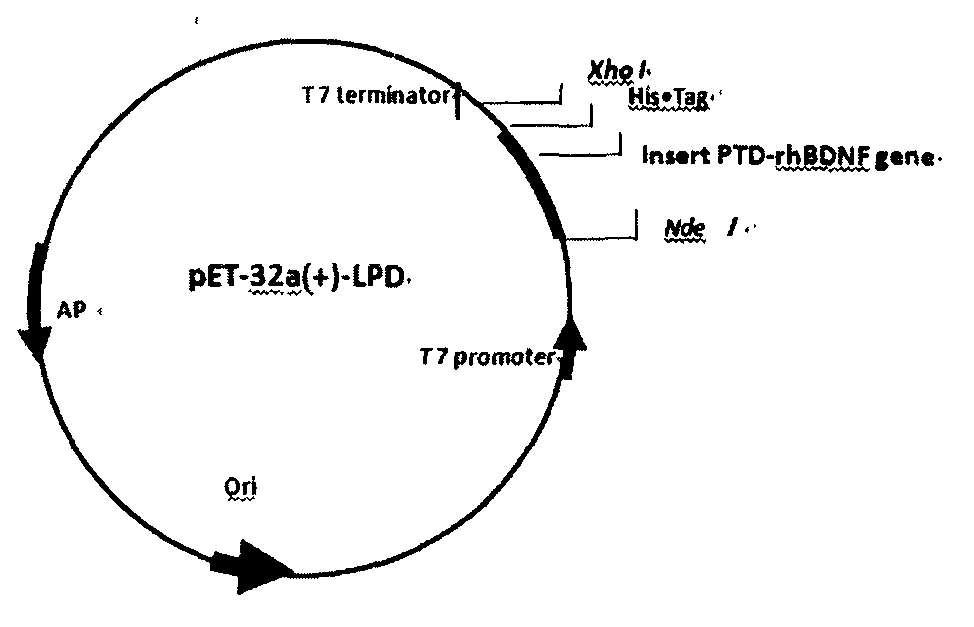Construction, expression and application of genetic engineering bacteria for high-production of beta-alanine
A technology of genetically engineered bacteria and alanine, applied in genetic engineering, application, plant genetic improvement, etc., can solve problems such as low enzyme activity and difficulties
- Summary
- Abstract
- Description
- Claims
- Application Information
AI Technical Summary
Problems solved by technology
Method used
Image
Examples
Embodiment 1
[0038] Embodiment 1: Construction of high expression vector
[0039] Primers were designed according to the sequence of the L-aspartic acid-α-alanine decarboxylase PanD gene (NCBI Reference Sequence: NC_004567.2) of Lactobacillus plantarum WCFS1 plant Lactobacillus:
[0040] Forward primer: CGC CATATG TTAATTGATAT, the underlined sequence is the enzyme cutting site NdeI
[0041] Reverse primer: CC CTCGAG AACATATCAATTAA, the underlined sequence is the XhoI restriction site
[0042] The two ends of the gene sequence obtained by PCR have NdeI and XhoI sites, and the gene is inserted into the pET-32a(+) vector to obtain genetically engineered bacteria.
[0043] The protein expressed by the obtained genetically engineered bacteria has a His tag protein at the C-terminus, an XhoI site behind the His tag, and a stop codon TGA before the XhoI site after the His tag.
[0044] The NdeI restriction site in the described NdeI and XhoI restriction site is that NdeI has two restriction...
Embodiment 2
[0046] Embodiment 2: the acquisition of high expression bacterial strain
[0047] The prepared recombinant vector is introduced into Escherichia coli BL21, Rosetta or Origami by conventional methods to construct a genetically engineered bacterium in which the recombinant isomerase exists in the bacterium in a soluble form, and the successfully constructed genetically engineered bacteria are screened out, among which Escherichia coli BL21 The target protein expression of the recombinant bacterium as the host bacterium is relatively good. The engineered bacteria whose expression level of the target protein is not less than 30% shall be used as the engineered strains for production, and shall be preserved in the form of glycerol bacteria or milk freeze-dried strains.
[0048] The specific transformation method is as follows: Take out 100 μL of competent cells from the refrigerator. Thaw cells on ice for 2-5 minutes. After thawing, flick the tube wall 1-2 times to resuspend the ...
Embodiment 3
[0050] Example 3: Purification of L-aspartic acid-α-alanine decarboxylase in highly expressed strains
[0051] (1) Seed Medium Activation Pick a single colony on a petri dish and place it in 5 mL LB (Amp 100 μg / ml) medium, and activate overnight at 37° C. and 200 rpm.
[0052] (2) Fermentation culture Inoculate 800 mL of LB medium (Amp 100 g / mL) with the overnight activated seed solution at a ratio of 1:100, and culture at 37°C and 200 rpm until mid-log phase OD600=0.6-1.
[0053] (3) Induction culture In the mid-log phase, IPTG was added for induction, so that the final concentration was 0.5 mM, and the induction culture was carried out at 25-30° C. and 180 rpm for 4-6 hours.
[0054] (4) SDS-PAGE Take 4 mL of the fermented broth that has been induced, centrifuge at 12,000 rpm for 90 sec, add 800 μL of deionized water, and sonicate for 5 min. Centrifuge at 12000rpm for 10min. Take 20 μL of supernatant after centrifugation and add 5 μL of loading buffer; after centrifugation...
PUM
 Login to View More
Login to View More Abstract
Description
Claims
Application Information
 Login to View More
Login to View More - R&D
- Intellectual Property
- Life Sciences
- Materials
- Tech Scout
- Unparalleled Data Quality
- Higher Quality Content
- 60% Fewer Hallucinations
Browse by: Latest US Patents, China's latest patents, Technical Efficacy Thesaurus, Application Domain, Technology Topic, Popular Technical Reports.
© 2025 PatSnap. All rights reserved.Legal|Privacy policy|Modern Slavery Act Transparency Statement|Sitemap|About US| Contact US: help@patsnap.com



